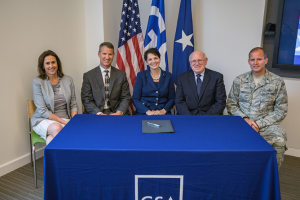We pride ourselves on providing federal agencies with IT solutions at the best value through an efficient buying experience.
To further improve the buying experience, the Governmentwide Strategic Solutions (GSS) for desktops and laptops program formed a partnership among procurement teams from agencies across government. Working closely with our industry partners, the GSS team negotiated better terms and conditions, more consistent pricing, and a streamlined buying process for federal, state, and local governments.
The government depends on desktops and laptops every day to accomplish its mission. More than $1 billion is spent annually on this critical IT hardware. Most of this $1 billion is spent on similar desktop and laptop configurations from the same original equipment manufacturers, but spread across thousands of different contracts.
The Workstation Category Team, established by the Office of Management and Budget (OMB), worked closely with agency and industry stakeholders to create GSS standard configurations. They’re designed to meet 80 percent of the government’s desktop and laptop requirements, helping the government aggregate demand and use its consolidated buying power.
How’d we do it?
The category team worked to ensure participating contractors offer the full breadth of GSS-compliant desktops, laptops, options, and accessories through their IT Schedule 70 contracts. Also, GSA Advantage catalogs for GSS desktops and laptops were fully overhauled to clearly show compliant machines, with full descriptions and a menu-driven option and accessory configurator.
To make buying these products quick and easy, IT Schedule 70 awarded three multi-agency (government-wide) single-award Blanket Purchase Agreements (BPAs) to support OMB’s GSS Desktop and Laptop category management strategy.
These BPAs are recompeted annually to ensure the latest technology is available in a GSS-compliant configuration, at the most competitive prices in government.
These three BPAs are available via the GSA AdvantageSelect buying platform.
Better Buying for the Future
GSS program use has increased nearly 700 percent over the last two fiscal years. At the same time, use of our AdvantageSelect GSS BPA has increased by 400 percent from FY17.
The discounts realized through the competitive process encouraged this growth. Agencies executing large-quantity purchases through GSA’s GSS Program in FY18 have realized discounts of up to 40 percent off GSA contract ceiling prices.
To make sure everyone hears about this, GSA’s IT Hardware Category Management team hosts regular training sessions that tell agencies how to maximize savings and buying power for obtaining GSS-compliant desktop and laptop computers, as well as options, accessories, and peripherals at competitive prices.
These webinars make it easier for agencies to benefit from this outstanding program; learning more about simple purchasing options is especially important to government buyers as we near the end of a fiscal year. To learn more about the configurations and contracts and to make your purchase, see GSA Advantage or the Acquisition Gateway.
For GSA GSS Desktop/Laptop help, please visit our webpage or contact workstations@gsa.gov
Please follow us on Twitter @GSA_ITC and LinkedIn to join our ongoing conversations about government IT.
